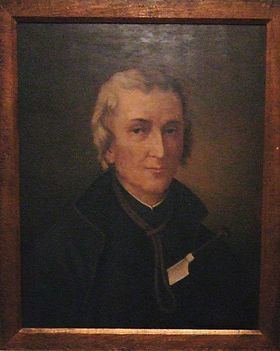Venerated in Catholic Church Feast 27 August | Name David Lewis Role Jesuit | |
 | ||
Beatified 15 December 1929 by Pope Pius XI Canonized 25 October 1970, Vatican City, by Pope Paul VI Died August 27, 1679, Usk, United Kingdom | ||
David Lewis (1616 – 27 August 1679) was a Jesuit Catholic priest and martyr who was also known as Charles Baker. Lewis was canonized by Pope Paul VI in 1970 as one of the Forty Martyrs of England and Wales and is venerated as a saint in the Catholic Church.
Contents

Early life
Lewis, the youngest of nine children of Protestant Reverend Morgan Lewis, the headmaster of a grammar school and Margaret Pritchard, a Catholic, was born at Abergavenny, Monmouthshire, in 1616.
At 16 years of age, while visiting Paris, he converted to Catholicism and subsequently went to study at the English College in Rome, where he assumed the alias "Charles Baker", a common practice to avoid spies and informers in the employ of the Crown. He was ordained a Catholic priest on 20 July 1642. Three years later, he joined the Society of Jesus.
Arrest and execution
He was arrested on 17 November 1678, at St Michael's Church, Llantarnam, then in Monmouthshire, and condemned at the Assizes in Monmouth in March 1679 as a Catholic priest and for saying Catholic Masses. Like John Wall and John Kemble, he was then sent to London to be examined by Titus Oates (the originator of the Popish Plot) and other informers.
He was brought for trial at the Lenten Assizes in Monmouth on 16 March 1679. He was brought to the bar on a charge of high treason – for having become a Catholic priest and then remaining in England.
He pleaded not guilty to the charge of being an accessory to the Popish Plot, but five or six witnesses claimed they had seen him say Mass and perform other priestly duties. For this Lewis was found guilty and sentenced to death by Sir Robert Atkyns. The condemned priest was brought to Newgate Prison in London with John Kemble (Herefordshire) and questioned about the "plot". Oates and his fellow informers William Bedloe, Stephen Dugdale and Miles Prance were unable to prove anything against him. Lord Shaftesbury advised him that if he gave evidence about the "plot" or renounced his Catholic faith, that his life would be spared and he would be greatly rewarded. Lewis said in his dying speech, "discover the plot I could not, as I knew of none; and conform I would not, for it was against my conscience".
He was finally brought back to Usk in Monmouthshire for his execution by John Arnold of Monmouthshire, prayed at the Gunter Mansion and was hanged on 27 August 1679 and then posthumously disemboweled. It was a tribute to the great esteem in which he was held that the crowd, who were mainly Protestants, insisted that he be allowed to hang until he was dead, and that he receive a proper burial. The Sheriff, who knew and liked Lewis, registered a silent protest by refusing to attend the execution, which he had postponed for as long as he could.
After the Titus Oates affair (1679–80), the remaining Welsh-speaking Catholic clergy were either executed or exiled. Lewis was the last Welshman to become a Jesuit until 2001, more than 300 years later.
Recognition
Together with John Wall, John Kemble and 37 other martyrs, David Lewis was canonized by Pope Paul VI in 1970 - the Forty Martyrs of England and Wales. In November 2007, a plaque was erected on the spot where Lewis was arrested near Llantarnam Abbey.
